DO-IT News July 2011

Volume 19, Number 1
Below are the articles of the DO-IT News July 2011 newsletter. These articles can also be seen all on one page at the Full Newsletter option.
Director's Digressions
Meet the 2011 DO-IT Scholars!
This summer DO-IT will host its nineteenth annual Summer Study program for DO-IT Scholars, providing participants with the opportunity to experience life on a college campus and explore challenging academic and career fields such as those in science, engineering, and computing. Primary funding for the Scholars program is provided by Washington State. Additional funding for Scholar activities is provided by Microsoft, the National Science Foundation, the National Oceanic and Atmospheric Administration, and The Boeing Company. For more information about the program, visit www.washington.edu/doit/do-it-scholars
Please join us in welcoming the following 2011 Scholars to DO-IT! Participants are selected from sophomore and junior applicants in high schools across Washington State.
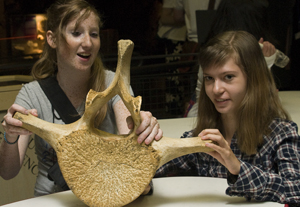
Kim, who has ADHD, wants to be a special education teacher. Her favorite classes are science and health. Kim is a tutor at her local elementary school and is involved in drama and Family, Careers, and Community Leaders of America.
Tess, who lives in Seattle and has dysgraphia and ADHD, would like to pursue a career in design, communications, or psychology. She has been training with Guide Dogs for the Blind since she was in third grade.
Paige, who has cerebral palsy, lives in Silverdale. Paige would like to pursue nursing or physical therapy so she can help others and motivate them to succeed.
Jae would like to be an assistive technology specialist. She enjoys European studies and English, particularly writing to express how she is thinking or feeling. Jae lives in Sammamish and has cerebral palsy.
Diego, who has a learning disability, lives in Lynnwood. His favorite classes are history and science. Diego would like to pursue a career in the sciences or finance.
Cecily's favorite classes are photography and French. She would like to study psychology or social work in college. Cecily has arthrogryposis.
Mauricio lives in Burien. His favorite subjects are math and history. Mauricio, who has a visual impairment, plans to study social sciences to better understand what motivates people and societies.
Joshua has Asperger syndrome. His favorite academic courses are social studies and language arts. Joshua enjoys recreational reading.
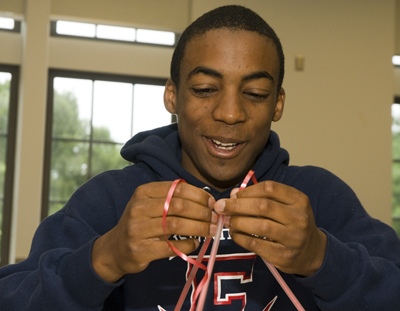
Deicy, who has spina bifida, lives in East Wenatchee. Her favorite classes are concert choir, design, reading, and writing. Deicy hopes to work with children after college.
Zachariah lives in Camas. His favorite classes are math and science. He is exceptionally talented in the area of mathematics. Zachariah has neurofibromatosis type 2.
Emily, who lives in University Place, is blind. She is interested in math and would like to continue her mathematics studies in college. She hopes to work in research and development of new tools for people with visual impairments.
Erika lives in Woodinville. She is deaf in both ears and has two cochlear implants. Erika loves math and enjoys science. She would like to pursue a career as a doctor or forensic scientist.
Sean William has varsity letters in basketball and football from Woodinville High School. He enjoys studying math and chemistry. Sean has arthrogryposis.
Macy lives in Federal Way. English and science intrigue her. She hopes to complete high school with her associate of arts degree through Running Start. Macy would like to pursue a master's degree in psychology. She has cerebral palsy.
Kaylie, who lives in Renton, is deaf. Her favorite subjects are history and digital communications. Kaylie would like to be a psychologist working with children or teens.
Jessie's favorite academic courses are history and English. Her dream job is to be a concept or story-board artist/animator or an illustrator for children's books.
Vaughn lives in Snohomish. He enjoys science and German. He hopes to visit Germany some day. Vaughn has a hearing impairment and fine motor weakness.
DO-IT Ambassador Profile: Blake Geyen
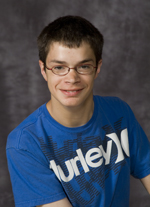
Hello. My name is Blake. I began as a DO-IT Scholar in 2007 and became a DO-IT Ambassador after I transitioned to college. Currently, I am a third year business major at Saint Martin's University. I am considering a concentration in business management and economics. After graduating, I am interested in working in the public transportation field. Public transportation has helped me become very independent, and I would like to help others become independent as well.
When I was born, I was asphyxiated at birth for nine minutes, which caused me to have cerebral palsy. I can walk with a walker for short distances, but I primarily use an electric wheelchair. In the first grade, I told my mom I wanted to join boy scouts. She thought it was all knot tying and hiking—something that I could not do. However, I joined, and it has been the greatest thing I have ever been involved in. I went camping, learned valuable skills, had a chance to experience the outdoors, and even broke off the back wheels of my electric wheelchair playing tug of war at summer camp. My participation taught others that anyone can be in scouting, even people with disabilities. As a scout, I was just "one of the guys." On March 17, 2009, eleven years after I joined the scouting program, I became an Eagle Scout.
In my spare time, I enjoy getting a mocha frappuccino from Starbucks, going for walks in my wheelchair on trails, hanging out with my family, and walking my dog Krystal.
The DO-IT Scholars program has been very helpful as I transitioned from high school to college. One important lesson I have learned through DO-IT is to advocate for myself. Before DO-IT, I would let other people make decisions for me. Through DO-IT, I learned to play a more active role in decisions that affect me. This is extremely important as I plan to live on my own.
Staff Profile: Jodi McKeeman
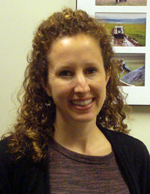
Hi, my name is Jodi. I started working at DO-IT in February 2011 as manager of program operations. I help to ensure all of the day-to-day operations of the office run smoothly.
I was born and raised in Seattle…Ballard High grad here! I completed my undergraduate program at the University of California Berkeley and a few years later earned my master's degree in tourism administration from George Washington University in Washington D.C. I spent the following five years working in international development in project and program operations management. I spent four of those years living in Cape Town and travelling throughout Africa and one year in Miami. My husband and I then decided to cut down on our international travel and moved back to the Pacific Northwest last year, when we had our daughter, to be closer to her grandparents. These days, when I'm not at work, I'm spending my time awestruck, witnessing and enabling an infant-going-on-toddler to learn about the world around her.
I'm very happy to be with DO-IT. I'm still learning but I already know that I truly admire all the great work that is done here, and I'm thrilled to contribute my operations management skills to help build better programs for students.
Microsoft Mentoring Day
This spring, DO-IT held its second Mentoring Day with Microsoft. Nine mentors from Microsoft and fifteen students from local high schools, community colleges, and the UW met for mentoring and networking over pizza. Each of the students had the opportunity to engage with mentors and ask for advice, such as how to best succeed in school, what should be considered when planning a career, and the importance of internships.
Mentors enjoyed meeting with the students and discussing career options. Students also enjoyed the event and reported learning many things, including:
- There is terrific support available for STEM studies and careers.
- It is good to know about the variety of job opportunities available.
- I learned ways to improve my resume.
- The degree you have is not as important as demonstrating that you have potential.
- I learned how important internships are while in school.
- Large companies like Microsoft look for people who have vision in that industry, including those who stay on top of industry news.
- I need to act on the thing I want to pursue and take classes and learn a lot about that thing. Because if you have knowledge, then you have power.
Engaging in Access to Design
High school and college students with disabilities interested in architecture, landscape, interior, and other design fields gathered this June for the AccessDesign workshop. Students spent one day at the University of Washington and another at one of the leading architecture firms in Seattle. The event was a great opportunity for students to learn about design degrees; meet professionals in the field, including those with disabilities; interact with successful college and graduate students with disabilities; and participate in hands-on design activities.
DO-IT Internships
Internships help students build their network of professional contacts and build a list of job references. They offer opportunities to practice disability disclosure and requesting accommodations. In addition, they help develop self-advocacy skills and strengthen student resumes.
DO-IT participants have completed over eighty challenging internships in the last year! Students have worked in locations such as the Renton Public Library, Tethers Unlimited, InterConnection, Invision Learning, the Deaf-Blind Service Center, DataNumerica, the Equal Employment Opportunities Commission, NASA, the UW Medical Center, Seattle Public Library, the National Oceanographic and Atmospheric Administration, and several postsecondary institutions across the country.
Several students created new computer programs and completed training in web accessibility. Others worked on mechanical engineering projects, astronomy research, marine biology research, lab management, program management, biology research, and electrical engineering projects.
As a result of internship engagement, DO-IT student interns regularly report that they are more motivated to study and work toward a career, are more knowledgeable about career interests, have improved their ability to work with co-workers and supervisors, have improved job skills, and have learned about accommodations for work.
Students who want to know more about internship opportunities can consult the following DO-IT publications:
- It's Your Career: Work-Based Learning Opportunities for College Students With Disabilities
- Learn and Earn: Tips for Teens
They can also contact DO-IT program manager Scott Bellman at swb3@uw.edu
Engineering Discovery Days
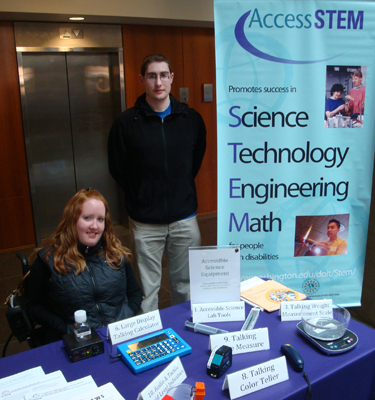
This spring, AccessSTEM participated in the University of Washington Engineering Discovery Days. The event gave hundreds of K-12 students, families, and educators a chance to view exhibits related to all things engineering! AccessSTEM hosted a table in the Computer Science and Engineering building, showcasing accessible science equipment and adaptive computing technology. Many attendees tested out our accessible science equipment and computers with special screen reading software. Whether you have a disability or not, anyone can have fun learning about assistive technology!
Paws on Science
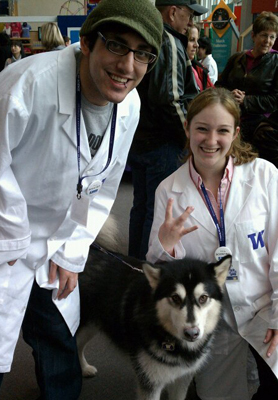
What happens when you mix science, the University of Washington, and Seattle together? Why, you get Paws on Science, of course! This annual spring event is an opportunity for UW scientists and researchers to come together at the Pacific Science Center and present current projects to the public. DO-IT's AccessSTEM project was invited to participate among the 30 research groups this year at the three-day event. The AccessSTEM table, titled "Any Student Can Learn Science," displayed accessible science equipment that included:
- a talking reading pen
- a Brailled geometric set with a spur wheel used to demonstrate the creation of tactile images
- a talking color teller
- liquid level indicators
- a non-slip mat, and other tools
There were nearly 20,000 attendants, including 22 Sealth High School students with disabilities on an AccessSTEM-funded field trip. AccessSTEM's table visitors were enthusiastic to learn about the use of the accessible equipment, and DO-IT was excited for the opportunity to bring awareness to both the general public and research communities.
Web Accessibility Training at DO-IT
This spring, sixteen University of Washington students devoted the final few days of their spring break to learning about accessible web design. This was the fourth in an ongoing series of Web Accessibility Trainings (WAT) that DO-IT has conducted for high school and college students with disabilities since 2009. The trainings are provided with support from the AccessSTEM project, the goal of which is to help students with disabilities succeed in science, technology, engineering, and math (STEM) courses and reach critical junctures on paths toward college studies and careers in STEM fields. WATs help students learn the basics of web design, with an emphasis on how to create web pages that are accessible to all users, including those who are unable to see, unable to use a mouse, unable to perceive color, using smart phones or other mobile devices, and other accessibility issues. Following the three-day training, several participants continued on by conducting web accessibility evaluations on STEM-related websites.
Planning is now underway for a Fall WAT, which will take place September 20-22 at Seattle Central Community College. Stay tuned for additional information about this and other upcoming trainings.
Tech Tips: iPad—Mobility, Accessibility
I've had the good fortune to spend a couple of months with an iPad with a view to its utility in the education setting. This portable device is based on the iPhone operating system and will run applications developed for that platform, as well as programs designed specifically for the iPad's larger display.
Interface and Basics
The touch interface is easy to learn and intuitive for new users. More advanced actions that allow zooming can become second nature. The device is updated via the freely available iTunes software. I find iTunes to be challenging to use on an infrequent basis, however there are ample web sites available to assist with basic questions. The iTunes software is available for Windows or Mac operating systems, and with some emulation work, within some Linux variants as well.
Connectivity
iPads are available standard with wireless connectivity. This means that anywhere you can access a wireless hotspot, you can get online. An additional feature is 3G connectivity, which is available from AT&T on a month-by-month basis. I did experience problems getting the wireless connection to work in some locations, with no apparent cause.
The touchpad keyboard used for text entry is really only suitable for short bursts of writing—quick email messages or short notes. For more involved writing projects I highly recommend an external Bluetooth keyboard, and my brief experimentation with a couple of these devices proves that it is fairly easy to pair a keyboard to an iPad. Without a physical keyboard, do not expect to be creating a lot of text!
Integration
Synchronizing standard email accounts so they are delivered to the iPad is straightforward and works well for mainstream services such as Google Mail and Microsoft-based email. The mail interface on the iPad is very basic, and a limitation that bothers me frequently is the inability to choose between deleting messages or having them archived. You can only set one or the other for the delete/archive action (a horizontal swipe of a message in the list view). Otherwise the built-in mail program does a great job of letting one stay in touch while away from a desktop or laptop computer. This integration also works well for Google Calendars, and allows me to see both my personal and work-related calendar views in a single screen. Navigation is not as intuitive with this program, where one would be expect to swipe the page view to go forward or backward in the calendar. Instead, one must target the small buttons at the bottom of the screen.
Accessibility and Apps
From a usability standpoint, this device really shines. It's much easier to teach someone (an elderly relative for example) how to control the device and start browsing the web or using other applications quickly. The ability to zoom most any screen will assist those with limited vision, and Apple includes the VoiceOver screenreader built-in to every device (also with the other iDevices as well as their computers). Apple lists a large number of Bluetooth Braille displays that provide access for those who prefer to read Braille.
If a person needs assistance with reading due to a learning disability, there are a number of additional programs (called apps) that can be downloaded at low or no cost from the iTunes store. SpeakIt is a $2 app that allows voicing of any text found in email, web pages, and PDF files.
The most expensive app I've purchased is one that allows me to control some of my computers remotely. This is one way to overcome the inherent limitations of the iPad. With use of the Jump Desktop software, I can connect with computers at home or at work if I need to access files or use programs that aren't available within the Apple operating system. Controlling a Windows computer while using an iPad feels a bit surreal at first, but it is quite useful when needed.
The app I find of most use on the iPad is Evernote, a notetaking consolidation program that allows you to synchronize short documents between the iPad and Windows or Mac computers via a central account you set up. Evernote can read PDF documents and will also record audio while notetaking, which can be a very valuable tool for some students. The basic version is free and as all other apps, available through the iTunes store.
Summary
I was not prepared to enjoy using the iPad as much as I have; it now travels with me while at work and between work and home. The prospect of being forced to use iTunes software kept me at a distance for quite some time, as well as the closed architecture employed by Apple to control access to the device except through the limited interface. Many people concentrate on the games that are available for this device, but there is much more usefulness within the small glass square than knocking pigs askew! What I've discovered is a useful mobile tool for staying in touch via email and staying informed via the web. However it is not a substitute for a laptop or desktop computer due to the limited interface, even with an external keyboard. It is more portable than other computing devices, and with its built-in accessibility and low cost apps for productivity, something to be considered as an option above and beyond your basic desktop or laptop computer.
The Thread: Accepting Assistance
I wanted to share with you a question posed by a DO-IT Ambassador within our Internet discussion forum and some of the responses, so you can get the flavor of the many rich conversations the DO-IT community has online. Some forum posts are edited for clarity and brevity.
I'd like some suggestions regarding one of my most recent experiences. I had just completed an interview and had called for a cab. Over an hour passed, but no driver showed up. The HR specialist from my interview found me standing and waiting in front of the building. She felt like she needed to assist by taking me to a transit station. I, however, kept trying to decline her assistance because I knew she had employees to supervise. My questions are:
- Would you have gone ahead and accepted her assistance? I had visited with her at the beginning of my interview so it was not like I was accepting assistance from a total stranger.
- What would you do if no one had offered their assistance and you did not get the transportation you needed for over an hour?
DO-IT Ambassador: If none of my modes of transportation were available due to delays, I would hop on any opportunity to get a lift regardless of abilities or disabilities real, perceived, or otherwise.
DO-IT Ambassador: I do find that using taxis are a hassle and the drivers are often late. I don't really have trouble asking for help from others. But if someone couldn't help me, I'd wait for hours for the next bus or train. I also have flown across country alone once and have gotten help with airport transportation or the flight attendants. Most people are pretty understanding and I really try not to let my disability show. Bus customers can get snappy about late routes, but no one I asked for help from has ever turned me down.
DO-IT Mentor: First, my answers to your questions: Yes, if I hadn't found another way to depart after more than an hour of waiting, I would have accepted her assistance. I imagine that the transit station wasn't that far away, so it probably wouldn't have been a great inconvenience for her. I learned to always have a Braille reference card with me that lists phone numbers of the different taxi companies. You could do the same by saving the phone numbers in your cell phone. That way, if one taxi doesn't show up, you can call another. Personally, I would've probably first called the driver or the company dispatching the driver to find out the delay. If the taxi still didn't show up, I would call a different company after another ten minutes. I was lucky enough to encounter a driver who was reliable, and I have hired that driver to help me get to places. I found her through an airport service.
DO-IT Ambassador: I never worry about people taking issue with me accepting help they offered.
DO-IT Staff: I know that when we've had folks come for various interviews it wouldn't be unexpected for us to offer them help if their original means of transportation had failed and they were willing to explore other options. I could see us helping them figure out what buses to take or getting numbers for other cab companies, or if they just wanted to sit in our reception area until their transportation arrived.
I liked the earlier advice about checking in with the cab company if they are late and then checking in every ten minutes to make sure they are still coming to pick you up. At least then you have a better idea of when they will get there so you don't have to be standing out in the cold. I know that I can be stubborn sometimes and try to do things on my own. I've found that often times asking for help or accepting help when offered makes the task easier, faster, and I don't get as frustrated.
Original poster: I did check in with the cab company several times while I was waiting. Each time I called, the dispatcher said that they did not have a driver available in the area. Once the HR specialist drove me to the transit station, I was able to take the train to Beaverton and walk home. I told her that an instructor from the state commission for the blind would be showing me how to get to and from work by transit if I got the job. The lesson I learned from this experience is that not all transportation services serve the areas you need to visit on a regular basis. Therefore, careful selection of a company is extremely important. I might also consider taking transit to a nearby destination and then having the cab or volunteer driver take me the rest of the way. I would not have to pay as much for transportation, but the driver would get me safely to my interview.
DO-IT Mentor: Sounds like you did something that made sense. What matters most is that you're competent at using your tools and strategies for getting places, getting there on time when it counts, and dealing with unexpected situations in whatever way works best for you. If you feel that someone like the HR person needs to know, you can always explain your strategy as you did in this case.
DO-IT Mentor: When I was first injured it was difficult for me to accept assistance. Since then I have made a priority list of my goals. My first goal is to finish with graduate school. Standing around waiting for a bus keeps me from studying. Accepting the ride would get me back to working on my priority goal sooner. Thus, I would have accepted the ride. I believe everyone has to make their own goals and determine what is important for them. Where I live we are told the bus has a thirty minute window. If I did not see the bus at thirty-one minutes, I would call the dispatcher to find out the cause.
How Can You DO-IT?
- Sign up to receive DO-IT News if this newsletter was not mailed directly to you.
- Volunteer as a Mentor or to help with one of our Summer Study programs.
- Pass this newsletter on to someone you know who can benefit from our programs.
- Donate money to support and extend DO-IT activities including sponsoring Scholars from states outside of Washington, special events, work-based learning experiences, participant attendant or travel costs, refreshments for program participants, and creation and distribution of educational videotapes and publications.
DO-IT today by completing the form below! You may also make a secure online credit card donation at the University of Washington Make a Gift page by selecting the "DO-IT Program Gift Fund" option.
___ Sign me up to receive copies of DO-IT NEWS, a free program newsletter.
___ Send me more information about DO-IT volunteer opportunities.
___ I would like to make a donation (payable to the University of Washington, Federal ID#91-6001537) to support DO-IT operations.
___ I have enclosed a check for $____________
___ Please charge $____________ to my credit card.
___ VISA ___ Mastercard
Date _____________
Card Number __________________________ Expiration Date _____________
Card Holder Name ___________________________________________________
Signature _____________________________________________________
Address ____________________________________________________________
City __________________________ State _____________ Zip ____________
Phone: Home __________________________ Business ____________________
E-mail: ____________________________________________________________
Your gift is tax-deductible as specified in IRS regulations. Pursuant to RCW 19.09, the University of Washington is registered as a charitable organization with the Secretary of State, State of Washington. For more information, call the Office of the Secretary of State, 1-800-322-4483.
Mail to:
DO-IT
University of Washington
Box 354842
Seattle, WA 98195-4842
Thank you!
More About DO-IT
DO-IT News is published at the University of Washington with input from DO-IT staff, Pals, Scholars, Ambassadors, and Mentors. DO-IT is primarily funded by the National Science Foundation, the U.S. Department of Education, and the State of Washington.
DO-IT (Disabilities, Opportunities, Internetworking, and Technology) serves to increase the successful participation of individuals with disabilities in challenging academic programs such as those in science, engineering, mathematics, and technology. Primary funding for DO-IT is provided by the National Science Foundation, the State of Washington, and the U.S. Department of Education. DO-IT is a collaboration of UW Information Technology and the Colleges of Engineering and Education at the University of Washington.
Grants and gifts fund DO-IT publications, videos, and programs to support the academic and career success of people with disabilities. Contribute today by sending a check to DO-IT, Box 354842, University of Washington, Seattle, WA 98195-4842.
Your gift is tax deductible as specified in IRS regulations. Pursuant to RCW 19.09, the University of Washington is registered as a charitable organization with the Secretary of State, state of Washington. For more information call the Office of the Secretary of State, 1-800-322-4483.
To order free publications or newsletters use the DO-IT Publications Order Form; to order videos and training materials use the Videos, Books and Comprehensive Training Materials Order Form.
For further information, to be placed on the DO-IT mailing list, request materials in an alternate format, or to make comments or suggestions about DO-IT publications or web pages contact:
DO-IT
University of Washington
Box 354842
Seattle, WA 98195-4842
doit@uw.edu
www.uw.edu/doit
206-685-DOIT (3648) (voice/TTY)
888-972-DOIT (3648) (voice/TTY)
206-221-4171 (fax)
509-328-9331 (voice/TTY)
Spokane Founder and Director: Sheryl Burgstahler, Ph.D.